Community Tip - Stay updated on what is happening on the PTC Community by subscribing to PTC Community Announcements. X
- Community
- Creo+ and Creo Parametric
- 3D Part & Assembly Design
- How to put constraint on threads...
- Subscribe to RSS Feed
- Mark Topic as New
- Mark Topic as Read
- Float this Topic for Current User
- Bookmark
- Subscribe
- Mute
- Printer Friendly Page
How to put constraint on threads...
- Mark as New
- Bookmark
- Subscribe
- Mute
- Subscribe to RSS Feed
- Permalink
- Notify Moderator
How to put constraint on threads...
Attached is tie rod dwg. I am trying to do a FEA on the tie rod but results was not what I wanted.
Anyway, I will start by explaning this tie rod. There are four tie rod that hold two platen in place. The picture shows half of a tie rod cuz I used a symmetric constraint on it. The is a platen in between the two threaded area and two nuts are holding this platen in place.
It has thread diameter of 9 1/2". So just using basic calculation with 825000 pre load on the tie rod. The stress should be around 12500 psi. But using FEA software![]() (creo), the lowest stress I get by changing the constraint is 52000 psi. that's way too much for the material. I am wondering if I constraint it correctly.
(creo), the lowest stress I get by changing the constraint is 52000 psi. that's way too much for the material. I am wondering if I constraint it correctly.
Here is how i constraint it, I created a region where the nuts thread contact with the tie rod thread, I put the 825000 lb on this region on every thread.
Then on the opposite side of the thread (across from the above region, ie the slope part of the thread) I put a displacement constraint to constraint any movement on XYZ translation.
I am not sure if that's enough or can someone explain to me how to constraint a thread. Plus this part is relatively large so instead of drawing the actual thread, I drew it as a cut and revolve it then pattern it. I tried drawing the nuts in but the assembly would not mesh.
If someone who is can point me to a correct direction on how u would constraint this would be great. thanks in advance
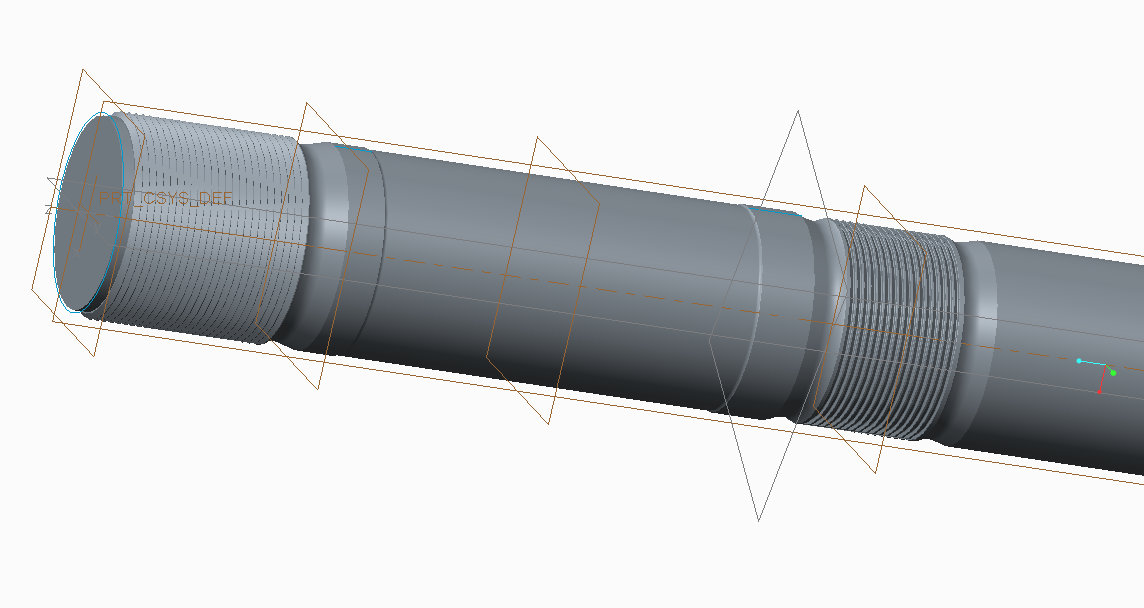
This thread is inactive and closed by the PTC Community Management Team. If you would like to provide a reply and re-open this thread, please notify the moderator and reference the thread. You may also use "Start a topic" button to ask a new question. Please be sure to include what version of the PTC product you are using so another community member knowledgeable about your version may be able to assist.
- Labels:
-
Assembly Design
- Mark as New
- Bookmark
- Subscribe
- Mute
- Subscribe to RSS Feed
- Permalink
- Notify Moderator
Hello Howard,
First, where are you wanting to calculate the stress? Are you expecting the rod to fail through the thread root? If not, there's probably no point trying to model the thread.
Assuming you do need to model the thread, I think your approach of modelling a simple revolve rather than a helix is a good one. I would go further with the symmetry, and use a 3.6° 'pie slice' of the rod - that way you're modelling 1/100th of the complete part, which makes dividing the load easy; and the model becomes small enough that you can use quite small elements in the critical region.
I'm not an expert in the mechanics of threaded joints, but my understanding is that the threads are not evenly loaded and that one or two may even be into yield. From this I'd say that you should really be trying to do a contact analysis with the nut, and that you should be using non-linear materials (available in WF5 and Creo 1 onwards, I think).
If you do want to try a simple linear analysis, then I'm not clear about your constraints but I would do it like this:
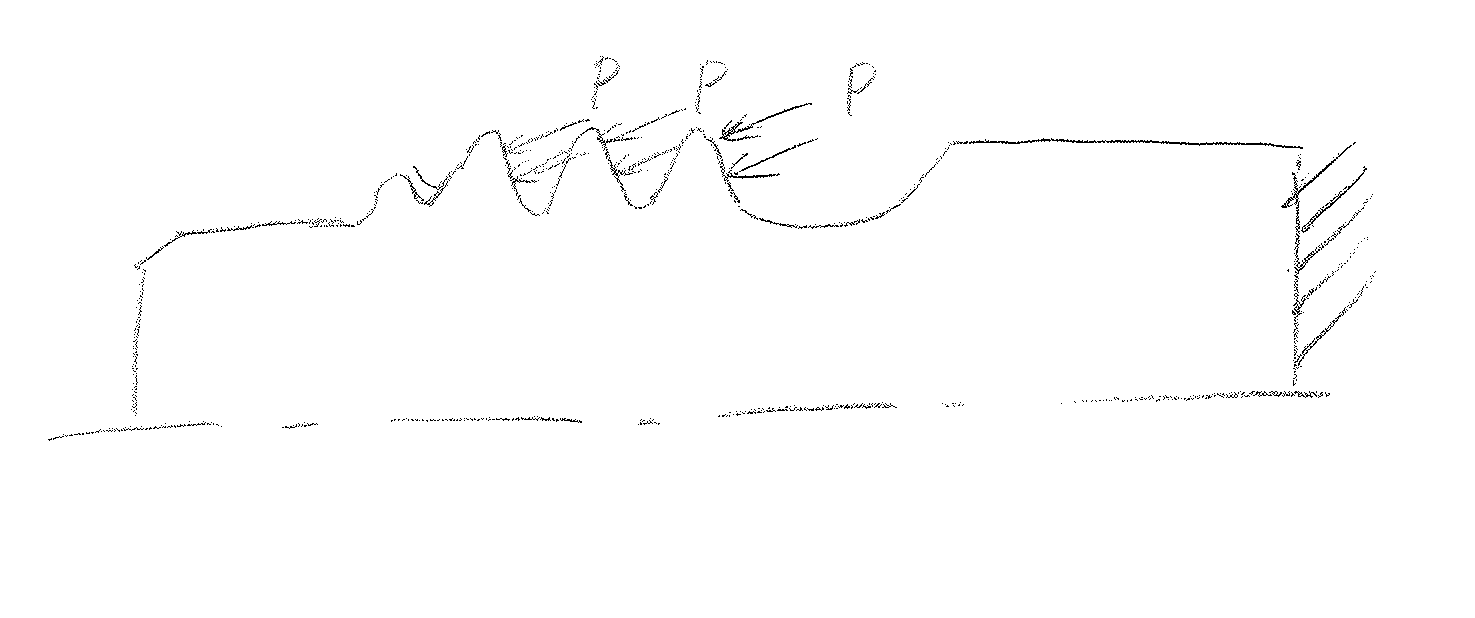
Cut the rod off a couple of diameters (so 20" or so) away from the end of the thread detail, and constrain it on the end face. Then apply a pressure load to each loaded thread flank, and use Review Total Load to adjust the pressure value until you get 8250 lbf total force (1/100th, remember) along the axis. The load distribution won't be right and you may get a stress concentration at the edge of the loaded surface, but it'll be a start.
Don't forget the cyclic symmetry constraint, too.
Also, model the smallest section of the component that you can get away with. If both threads are loaded but one is larger than the other, just model the smaller thread and cut the rod off before the larger one
HTH!
- Mark as New
- Bookmark
- Subscribe
- Mute
- Subscribe to RSS Feed
- Permalink
- Notify Moderator
I basically load the way u sketch, I create a region where the nuts thread supposed to came into contact with the rod thread. But I put my constraint opposite of the surface of where u applied P. P=825000 lb
I am under the assumption that if I cut the thread in half along the Z-axis, the elongation would not be correct cuz I think symmetric constraint restraited the displacement.
The front few threads should have higher stress which is expected but not to the value of 55K psi as the material only have yield strength of 36K psi and ultimate tensile strength of 70K psi. The highest stress should be at the root of the thread which it is correct. I will try to attched a results in a few.
And using simple hand calculation Force/area, stress should be around 13000 psi.
- Mark as New
- Bookmark
- Subscribe
- Mute
- Subscribe to RSS Feed
- Permalink
- Notify Moderator
What do you get from Review Total Load? Could you post a screenshot of the Review Total Load window after calculation?
I'm not sure what your concern is about using a symmetry constraint, and I don't understand why you're applying both the load and constraint to the thread...
- Mark as New
- Bookmark
- Subscribe
- Mute
- Subscribe to RSS Feed
- Permalink
- Notify Moderator
Where is review total load?
- Mark as New
- Bookmark
- Subscribe
- Mute
- Subscribe to RSS Feed
- Permalink
- Notify Moderator
In WF4 it's in the Info menu. Don't know about Creo - have you tried the command search?
- Mark as New
- Bookmark
- Subscribe
- Mute
- Subscribe to RSS Feed
- Permalink
- Notify Moderator
here is a screen cap
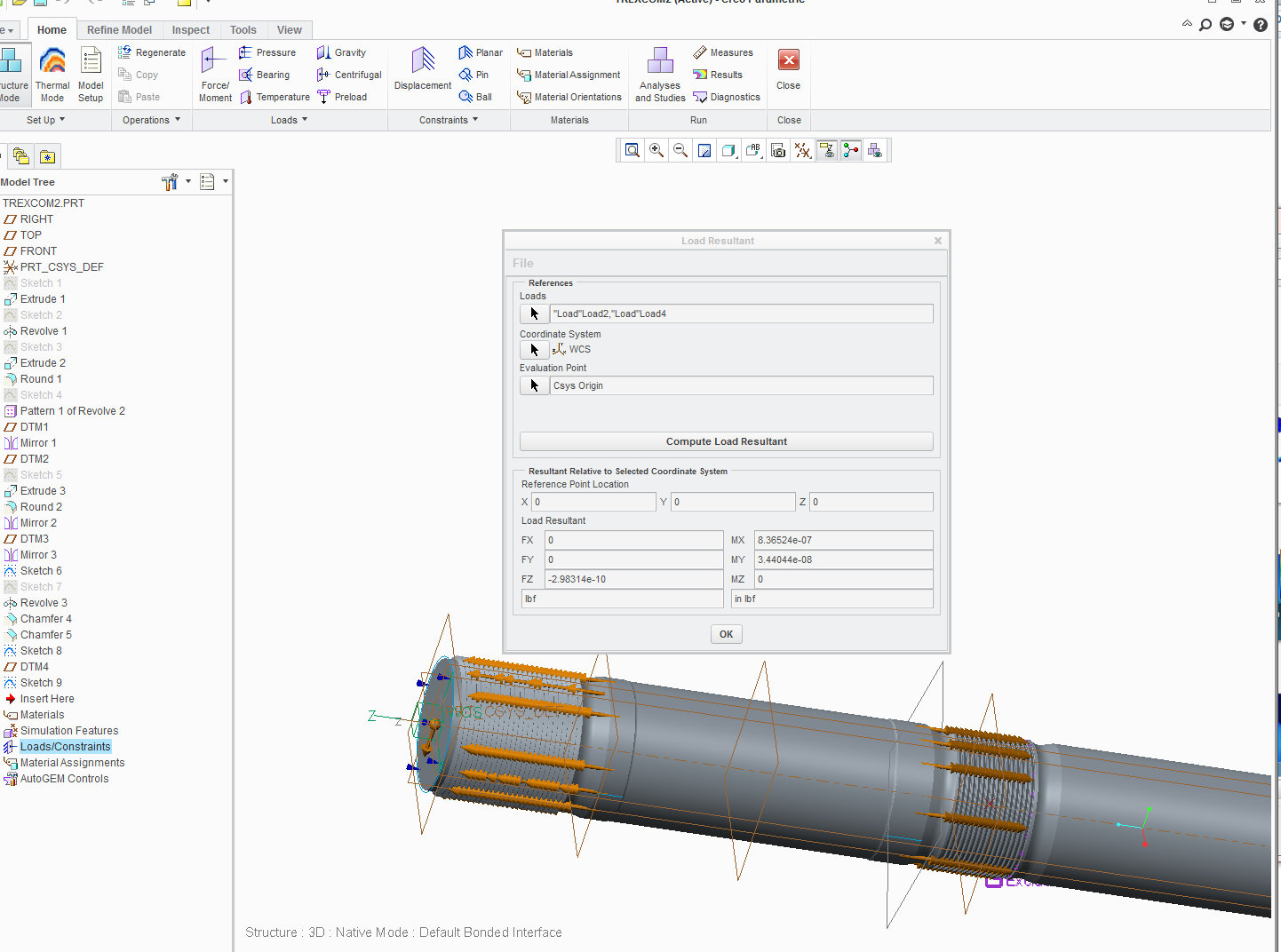
- Mark as New
- Bookmark
- Subscribe
- Mute
- Subscribe to RSS Feed
- Permalink
- Notify Moderator
OK - so you're using two opposing loads, rather than a load and a constraint. I also notice that you've deleted the symmetry cut you had earlier.
Try setting the model up using a 3.6° cyclic symmetry and only one of the two threads, as I suggested. Cut it and constrain it on the plane that's shown just under the OK button.
Then check Review Total Load (you should have 8250 lbf in Z) and we can have a closer look at the area with the highest stress - do a screenshot of the results, zoomed right in, with Show Element Edges selected. As it stands, the model is going to have way too many elements if we use the mesh density we need to get good results.
- Mark as New
- Bookmark
- Subscribe
- Mute
- Subscribe to RSS Feed
- Permalink
- Notify Moderator
Here is the latest attempt,

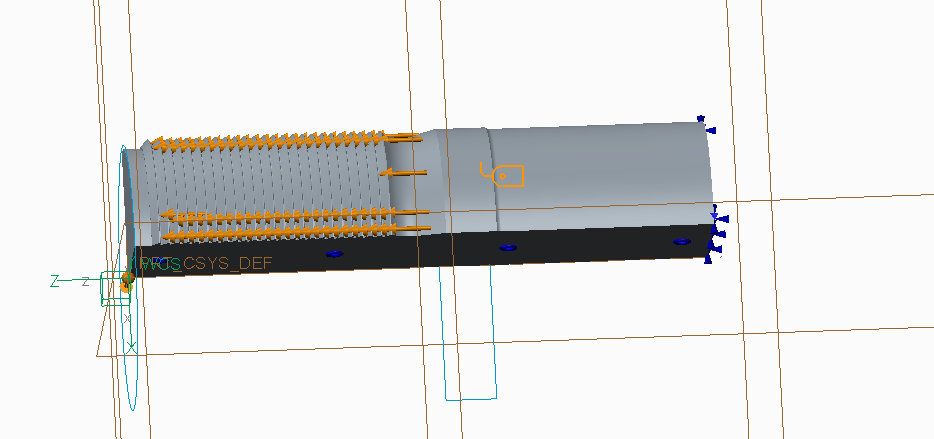
- Mark as New
- Bookmark
- Subscribe
- Mute
- Subscribe to RSS Feed
- Permalink
- Notify Moderator
Hello, Howard Lock,
I enclose a link to a file on the study of contacts between the threads.
Unfortunately, it is not in English.
Usually the charge is 50% on the first engaged thread and decreases on the second at 25% and 12%, 6%, 3%, 2%, .......
Cordially.
Denis__
- Mark as New
- Bookmark
- Subscribe
- Mute
- Subscribe to RSS Feed
- Permalink
- Notify Moderator
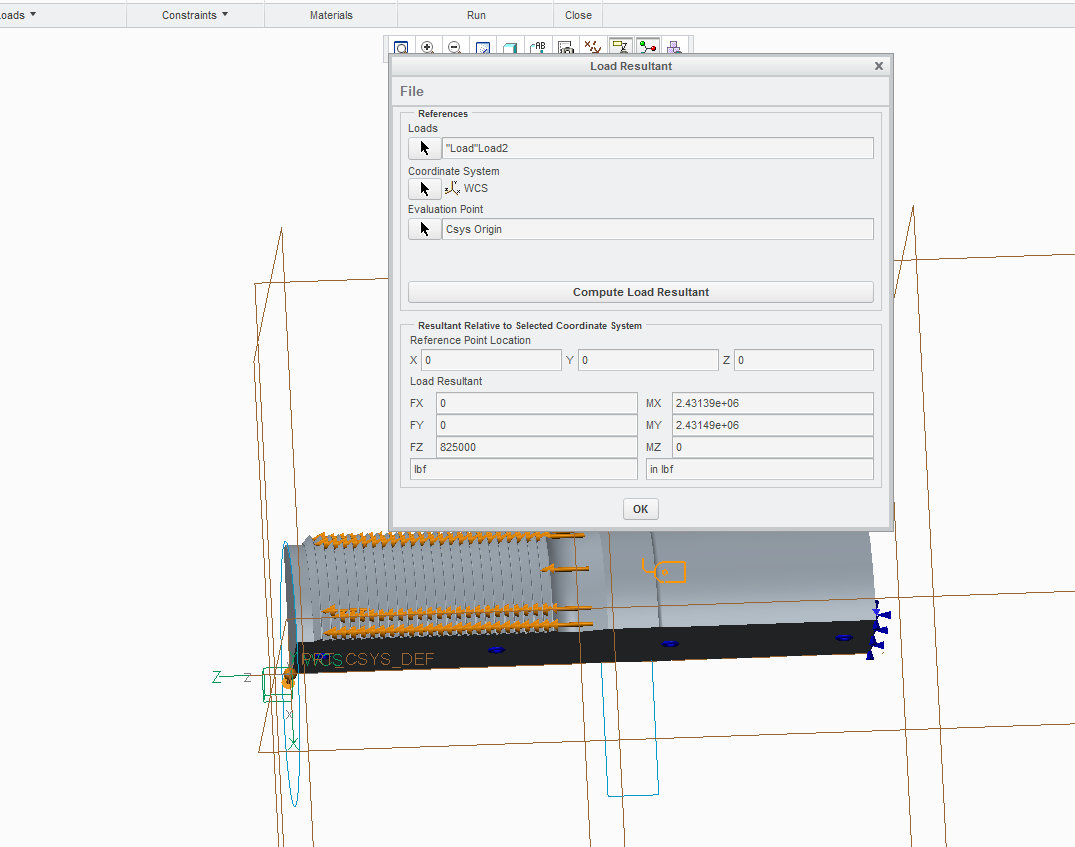
This is cotinue with my previous post.
The stress in the first groove is at 300K psi but on the second one it is 22K psi.
The stress at the first groove is definitely incorrect.
How can I fix this? Or do i constraint it right?
- Mark as New
- Bookmark
- Subscribe
- Mute
- Subscribe to RSS Feed
- Permalink
- Notify Moderator
When using any form of symmetry, you need to apply only the load that acts on the section of the part that you're actually analysing.
You're applying the full 825 000 lbf to a small fraction of the rod (although it looks wider than 3.6°... is it 36°?). You should divide the load by the same fraction that you've divided the rod, which will reduce the stress in direct proportion. To put that another way, if you're analysing half the rod you should apply half the total load; a quarter of the rod, apply a quarter of the total load; a tenth, a tenth of the load; and so on.
Also, you've used the 'smooth' stress display, and you're not showing element edges. Turning off 'smooth' and showing the element edges in areas of high stress gradient will help you to visually check the convergence, and therefore whether you need to refine the mesh.
As Chris said though, this can only give you an approximation to the real stresses...
- Mark as New
- Bookmark
- Subscribe
- Mute
- Subscribe to RSS Feed
- Permalink
- Notify Moderator
Jonathan,
Where to I go to change t0showing element edges?
- Mark as New
- Bookmark
- Subscribe
- Mute
- Subscribe to RSS Feed
- Permalink
- Notify Moderator
It should be in the result set-up window (WF4 shown, again):
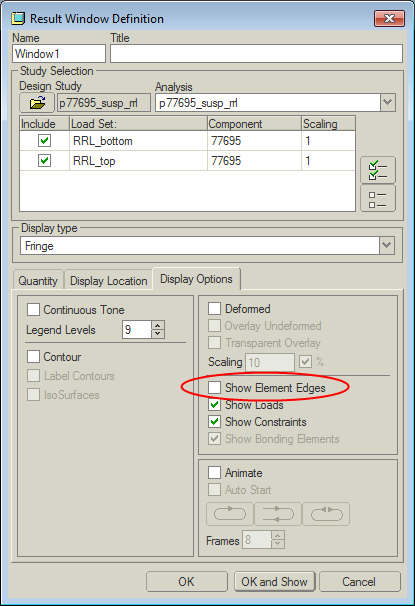
- Mark as New
- Bookmark
- Subscribe
- Mute
- Subscribe to RSS Feed
- Permalink
- Notify Moderator
What is it that you are trying to learn from the analysis? Do you need information on the thread root stress or are you looking for a way to pass the load into the shank/rod portion of your fastener? Either way, It is never recommended to conduct FEA on threads - it is widely recognized as a very difficult analysis to obtain even marginal results. “Handbook” calculations are often regarded as the best method to obtain root stresses. There is no symmetry in this type of part either. Of all the FEAs I've run in the past 20 years, I have run one thread simulation, under heavy protest with limited success, but only as a full contact model with its mating nut and using ANSYS with a highly refined mesh. The results provided the information we were looking for and the stresses were decent, but not as good as most any other type of analysis. Threaded fasteners are a highly non-linear beast, leading to the uneven, rapidly decreasing load sharing from the first thread onward. For an analysis of the rod itself, I would replace the threads with a cylindrical surface at the pitch diameter of the thread and apply the load at one end and a constraint at the other. Symmetry would easily come into play here to save a ton of solve time.
I hope this helps
- Mark as New
- Bookmark
- Subscribe
- Mute
- Subscribe to RSS Feed
- Permalink
- Notify Moderator
I need to prove that the highest stress at the tie rod is below the yield strength of the material (36K). Since the highest stress would be at the root of the thread, so I think I am looking for the root stress.
Can u show me where to get the "handbook" calculation? I am just using the total preload divided by the area of the root diameter. But isnt that mean every root thread have the same stress?
the thread is 9.5 major diamter, 3 tpi.
- Mark as New
- Bookmark
- Subscribe
- Mute
- Subscribe to RSS Feed
- Permalink
- Notify Moderator
Any good machine design reference will have methods to calculate root stress. More importantly, fasteners are typically designed to fail through the shank and not the threads. Many fastener manufacturers will provide a reference on the load limits of their fasteners. Your design appears to have a generous undercut which provides an ideal location to have the clapming system fail if overloaded. A simple F/A will do the job quite nicely for you if you evaluate this minimal cross-sectional area of your undercut.
There is a very good threaded fastener reference here:
http://www.bossard.com/en/Application-Engineering/Technical-Resources.aspx
- Mark as New
- Bookmark
- Subscribe
- Mute
- Subscribe to RSS Feed
- Permalink
- Notify Moderator
If you want to analyse root stress, you should create a nut and assemble it onto the screw.
You'll then have to create a 2D axisymmetric model (Edit>Mechanica model setup>Advanced>Type) and create contacts between every single teeth.
Here is an example of a threaded joint analysis:

FYI, when analysing a simpler threaded joint the computational time went from 49000s to 5s by changing the model type (from 3D model to axisymetric) with comparable results. (1:10.000 ratio, quite good isn't it?)
- Mark as New
- Bookmark
- Subscribe
- Mute
- Subscribe to RSS Feed
- Permalink
- Notify Moderator
Here is a very interesting discussion about thread analysis: http://communities.ptc.com/message/157166#157166
- Mark as New
- Bookmark
- Subscribe
- Mute
- Subscribe to RSS Feed
- Permalink
- Notify Moderator
This is really a stupid question, how do u create a 2D axisymmetric model? Do u mean draw a new one or create it out of my 3D model?
Please help.
- Mark as New
- Bookmark
- Subscribe
- Mute
- Subscribe to RSS Feed
- Permalink
- Notify Moderator
You can create it out of your 3D model.
You can create surfaces based on your parts. You also have to create a CSYS to define the axis of revolution (Y) and, of course, all of the surfaces must be on X-axis positive side.
Have a look at the Mechanica help files, they contain all informations about axisymmetric models.
- Mark as New
- Bookmark
- Subscribe
- Mute
- Subscribe to RSS Feed
- Permalink
- Notify Moderator
I do a 2D run...I am not sure about the results...I put the 825000 lbs on the face of the nut and contact surface between thread touching surfaces.
What do u guys think?
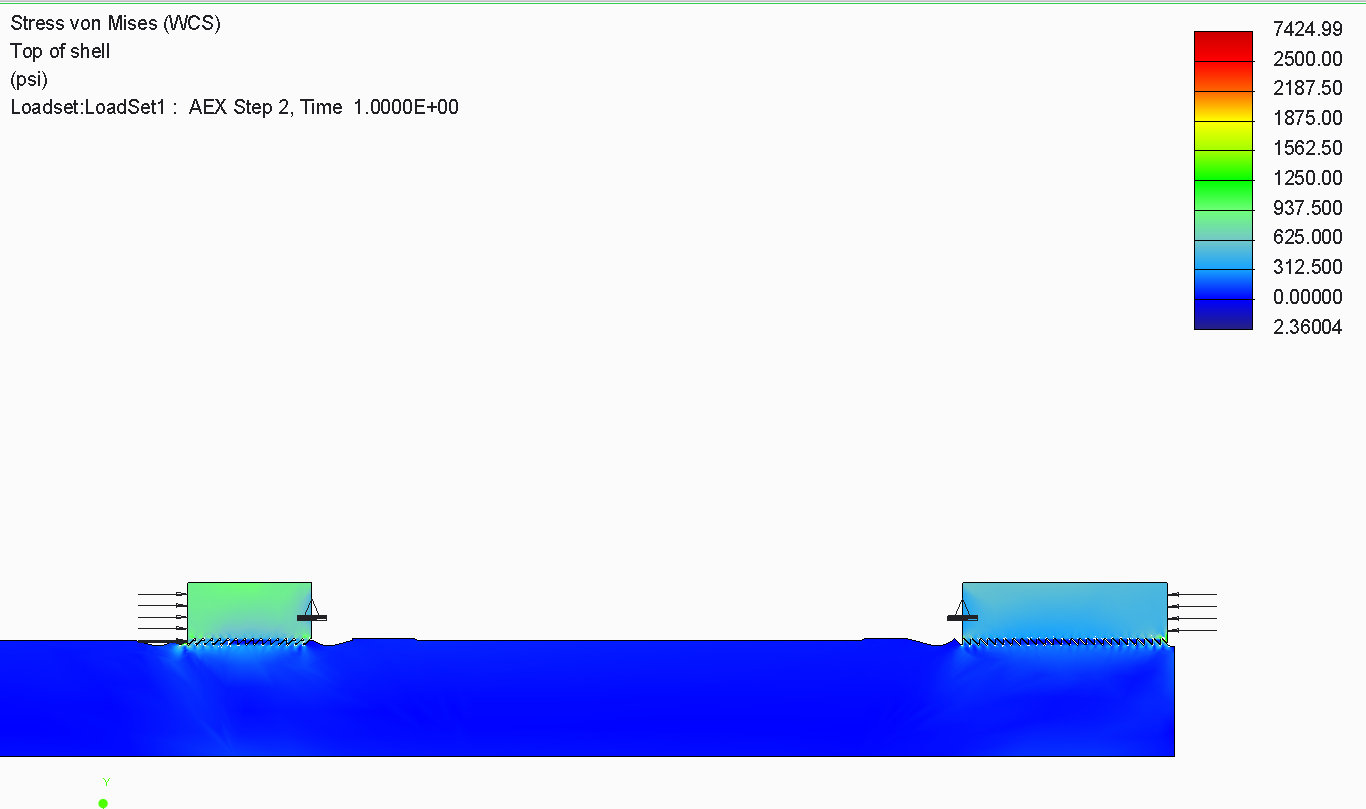
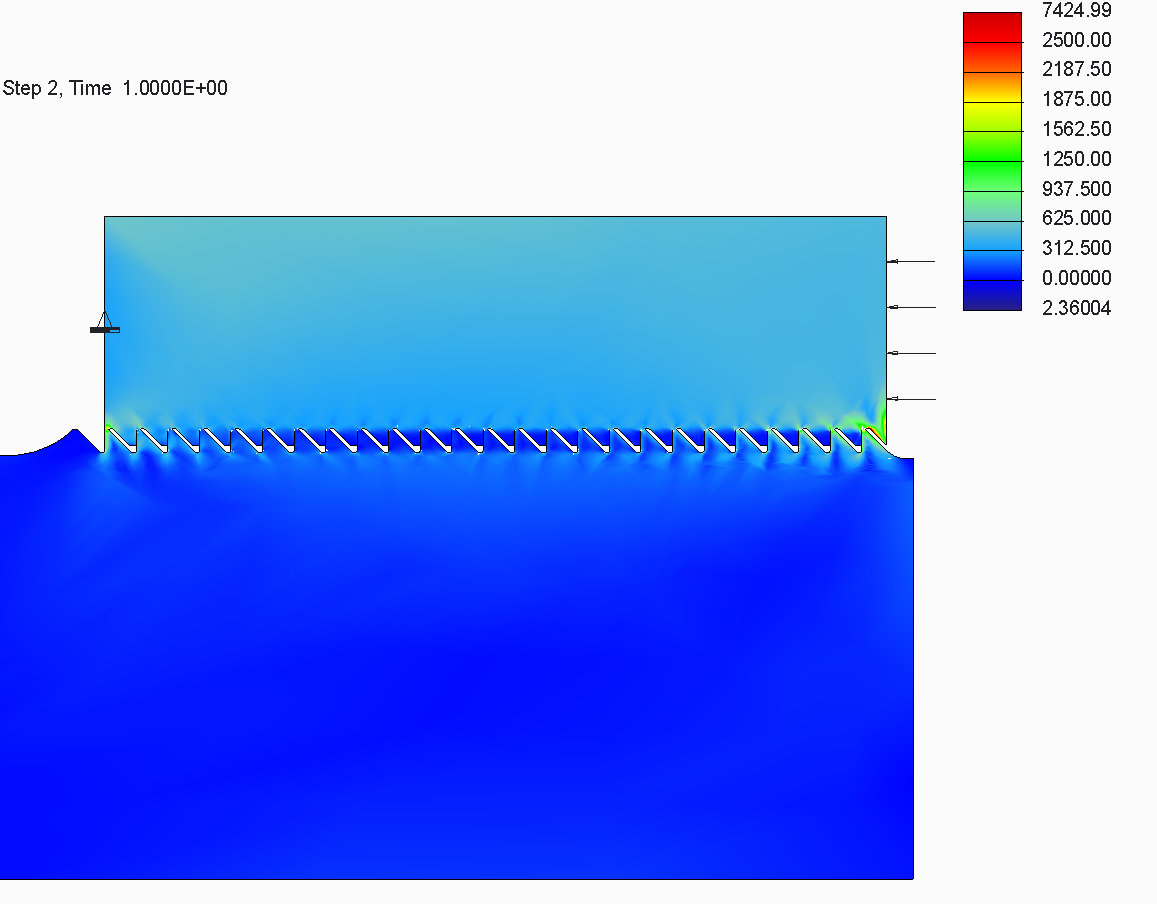
- Mark as New
- Bookmark
- Subscribe
- Mute
- Subscribe to RSS Feed
- Permalink
- Notify Moderator
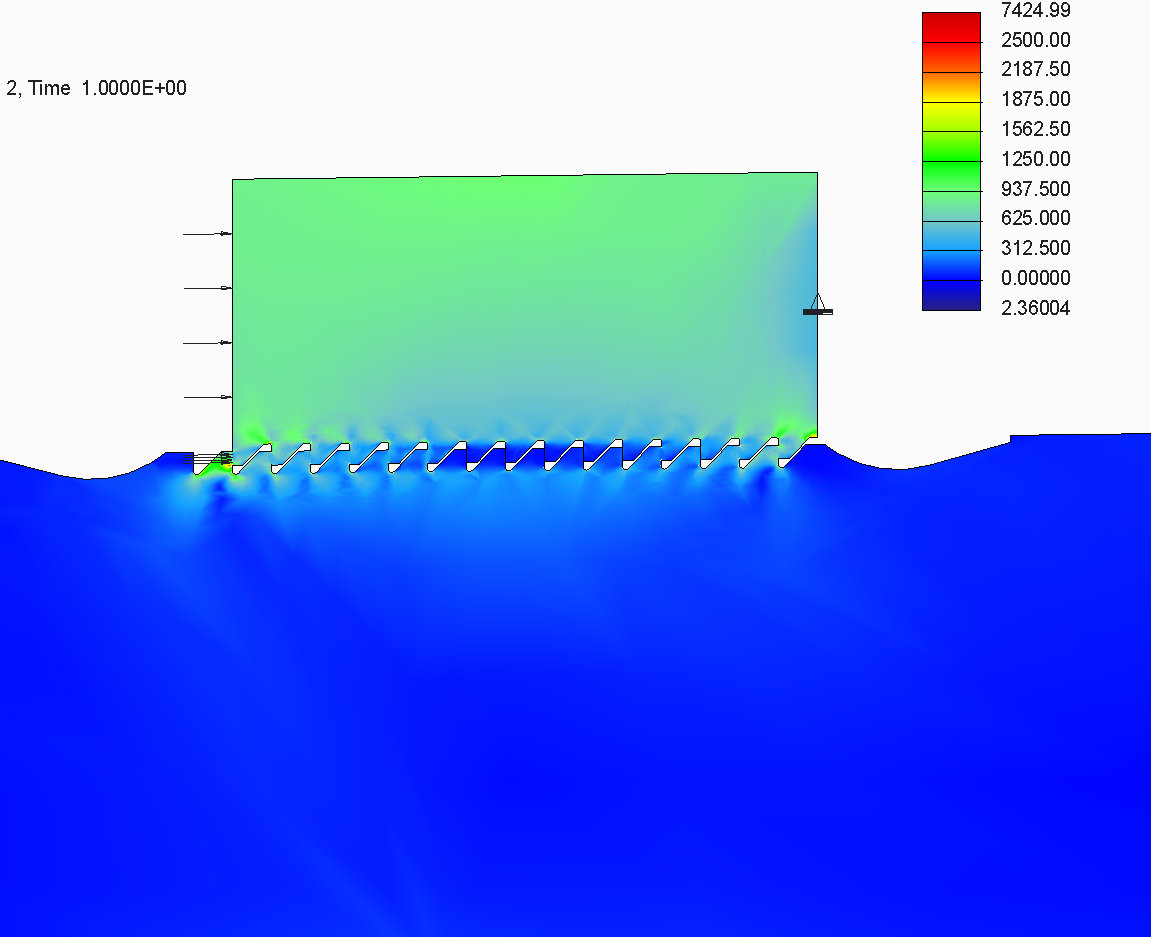
- Mark as New
- Bookmark
- Subscribe
- Mute
- Subscribe to RSS Feed
- Permalink
- Notify Moderator
Howard,
You seem to have applied both a load and a constraint to the nut. It looks like you're just squeezing the nut, and not transmitting any load through the rod...
- Mark as New
- Bookmark
- Subscribe
- Mute
- Subscribe to RSS Feed
- Permalink
- Notify Moderator
It also looks like you have bonded the nut's teeth with the rod ones. You must create contact interfaces instead of bonded interfaces.
- Mark as New
- Bookmark
- Subscribe
- Mute
- Subscribe to RSS Feed
- Permalink
- Notify Moderator
If the nuts are pressing a part, you shall apply the load on the inside surface of a nut and add a displacement constraint to the second nut's inside surface. It seems obvious that the teeth have to be loaded this way (they have a buttress profile).
A more realistic approach would be to add a 4th part representing the plate, to constrain displacement of one side of the plate and to add the load to the inner side of a nut.

- Mark as New
- Bookmark
- Subscribe
- Mute
- Subscribe to RSS Feed
- Permalink
- Notify Moderator
Thanks for all you guys input....I learned so much even though been doing FEA for couple of years...
Here is the latest attempt....I think this reflects more "realistic" result even though it is so much higher than hand calculation...what do u guys think?
Question When I do it in 2D, and cut the model at xy axis....do I have to reduce the preload? Full preload on the nut is 82500 lbs...I am running it with 825000 lbs...or should I run it with 412500 lbs?
Thanks

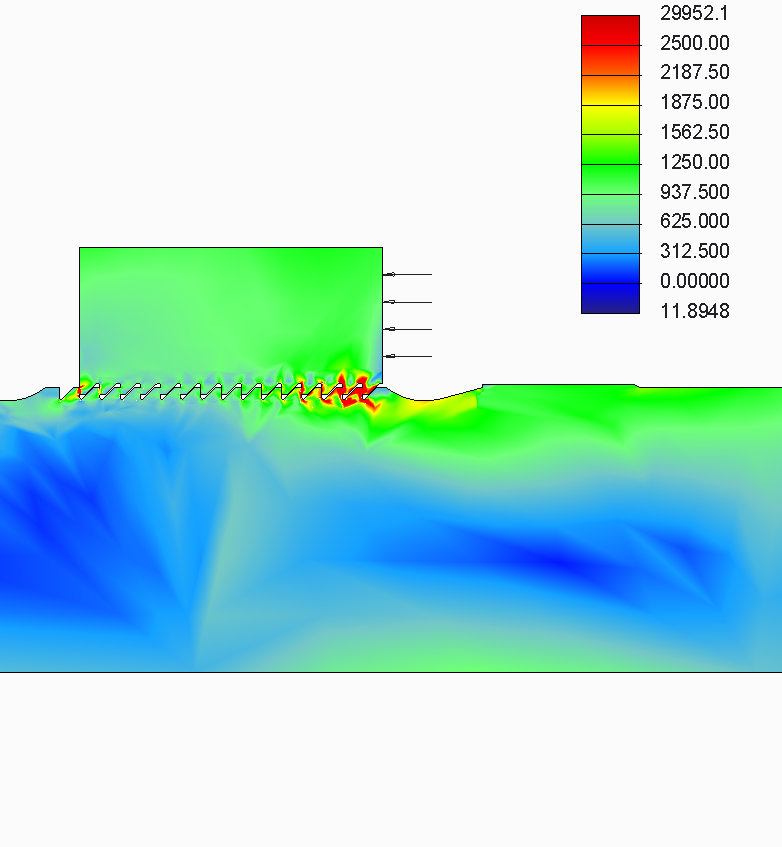
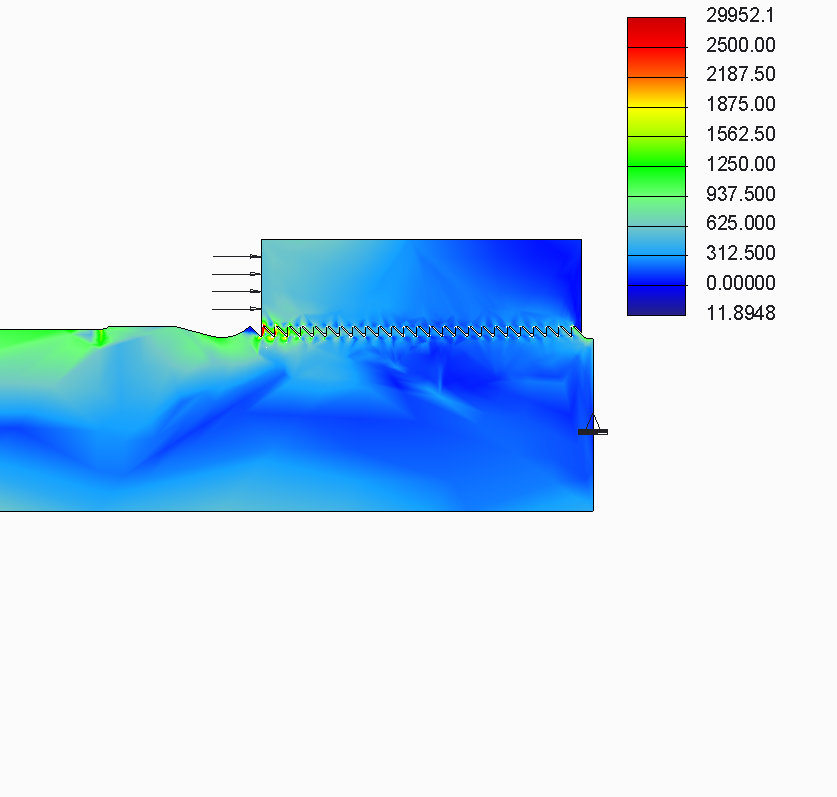
- Mark as New
- Bookmark
- Subscribe
- Mute
- Subscribe to RSS Feed
- Permalink
- Notify Moderator
You need to add the full load.
But the result should be more accurate if you delete the displacement constraint that is on the screw and replace one of the load by a displacement constraint that only fix the Y translation.
In the result window that shows the left nut, the stress of the leftmost tooth looks strange to me.
- Mark as New
- Bookmark
- Subscribe
- Mute
- Subscribe to RSS Feed
- Permalink
- Notify Moderator
Hi Sylvain,
What issue do you see with the way Howard shows the constraints above? Presumably his two forces are equal and opposite, which means that the displacement constraint should not see any load; in my experience this approach is often a good way to avoid over-constraint and artifical stress concentrations (but still to achieve 'necessary and sufficient' constraint).
My only comment is that the constraint is too close to an 'active' region of the part - assuming the constrained surface is where the rod has been truncated to reduce model size, I would move the truncation cut further away from the nut and threads, say at least two rod diameters.
That stress in the last thread does look strange though. Perhaps an exaggerated deformed results view would give some insight...
- Mark as New
- Bookmark
- Subscribe
- Mute
- Subscribe to RSS Feed
- Permalink
- Notify Moderator
That's because I don't like to see a "dummy" constaint near a stressed area, unless the stress is caused by this constraint (thus the constraint not being "dummy" anymore). It seems that it's your case too ![]() .
.
I mean, we don't know here if the shaft has to shrink or warp because of the thread load, thus I prefer not to constrain it.
If possible, I would have used an inertia relief in this analysis.





